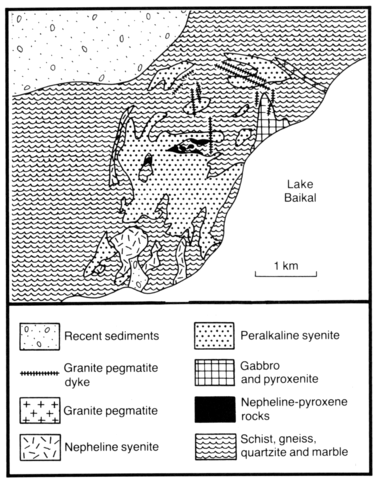stripes
The Tazheran occurrence comprises a number of intrusions lying within Precambrian schists, gneisses, calcite marbles and quartzites. Several stages have been established in the history of the intrusion, the first of which includes gabbro and gabbro-diorites, the second stage peralkaline syenite and later nepheline syenite, and the third stage veins, dykes and stocks of granite pegmatite. Pyroxenites and ijolites are present in the outer parts of the main intrusion, while at the outer contacts schists are altered to hornfelses, there is dedolomitization and recrystallization of marbles, and skarns are present. Desilication and alkalization have been recognised in granite pegmatites cutting alkaline rocks which, as a result, have been transformed into veins of aegirine syenite. The peralkaline syenites are the most widespread rocks in the massif and form an area of 1.5 x 1.5 km2 within which are small, isolated bodies of gabbro-diorite. These syenites are medium- and coarse-grained rocks with trachytic textures and sometimes gneiss-like structures. They are leucocratic rocks comprising mainly alkali feldspar and albite-oligoclase with augite and biotite. Nepheline syenites form several bodies to the west of the principal intrusion where they are up to 1.4 km in length and 150 m wide. In the south they are also well developed, the largest intrusion being a stock of 0.5 x 0.5 km in which contacts against alkaline syenite are gradational. are gradational. The nepheline syenites are generally trachytic rocks and consist of microcline perthite, albite-oligoclase, nepheline, aegirine-augite, hastingsite and biotite. Additional information can be found in Konev (1969).
KONEV, A.A. 1969. The Tazheran massif of gabbro, alkali and nepheline syenites. In E.P. Pavlovsky (ed) Geology of the Baikal Region. 121-7. Institute of the Earth's Crust, Irkutsk.

